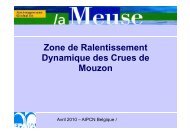PIANC E-Magazine - PIANC AIPCN welcome
PIANC E-Magazine - PIANC AIPCN welcome
PIANC E-Magazine - PIANC AIPCN welcome
You also want an ePaper? Increase the reach of your titles
YUMPU automatically turns print PDFs into web optimized ePapers that Google loves.
€<br />
• Active and passive earth pressure of the armour<br />
units adjacent to the crown wall should be calculated<br />
using the procedure presented in ROM<br />
0.5-2005.<br />
• Once the forces are calculated, the minimum<br />
weight of the crown wall can be obtained using<br />
ROM 0.5-2005, limiting the sliding security coefficient<br />
to 1.5:<br />
(Crown wall weight− ΣUp − lift forces)m<br />
CSD = =1.5<br />
ΣHorizontal forces<br />
(7)<br />
• Once the minimum weight calculated, the crown<br />
wall must be checked to make sure it is possible<br />
to achieve this weight with the proposed base<br />
and height dimensions. If the minimum weight<br />
cannot be obtained, the calculation process<br />
should be repeated changing Be and hƒ values.<br />
Finally, the load transmitted from the crown wall to<br />
the foundations should be checked to make sure<br />
it does not surpass the bearing capacity obtained<br />
with Brinch Hansen’s formula (ROM 0.5-2005).<br />
Shear stress should not exceed material resistance<br />
in the concrete joint according to article 47.2<br />
EHE (2008).<br />
The new methodology presented in this paper is<br />
simple and was obtained using irregular laboratory<br />
tests by means of linear regressions. Therefore,<br />
it is a robust method that considers the group<br />
waves effect.<br />
Cube-Cubipod comparison shows that Cubipod armoured<br />
mound breakwaters present lower forces<br />
(and therefore a smaller crown wall size) than the<br />
cube armoured ones. The result is the lower cost<br />
of the Cubipod armoured breakwater because of<br />
the smaller amount of concrete used.<br />
Future research will focus on the study of the cyclical<br />
forces that affect the crown wall foundations<br />
as a consequence of the sine-crest wave action.<br />
This issue should be addressed through numerical<br />
models that simulate the whole crown wall-soil<br />
system, using the necessary input parameters.<br />
The obtained formulae allow for the complete<br />
characterisation of sliding failure, although the<br />
pressure distribution is not defined. The distribution<br />
most similar to our tests is that presented by<br />
Pedersen (1996) (Figure 3c). Although the critical<br />
type of failure is totally defined with Fh and Fv(Fh),<br />
it is interesting to define the pressure distribution<br />
to characterise the stability of the whole crown<br />
wall.<br />
All the existing formulae (including the one developed<br />
in this paper) should be applied carefully<br />
considering the limitations on their application.<br />
Pressure distribution is currently one of our research<br />
topics, as well as the use of pruned neural<br />
network models to improve crown wall design<br />
considering wave and geometric conditions.<br />
6. REFERENCES<br />
Berenguer, J.M. and Baonza, A. (2006): “Diseño<br />
del espaldón de los diques rompeolas”, Libro de<br />
ponencias del II Congreso Nacional de la Asociación<br />
Técnica de Puertos y Costas, pp. 35-56 (in<br />
Spanish).<br />
Bradbury, A.P., Allsop, N.W.H. and Stevens, R.V.<br />
(1988): “Hydraulic performance of breakwater<br />
crown walls”, Technical Report SR 146, Hydraulics<br />
research, Wallingford, UK.<br />
British Standards Institution (1986): “BS 8004:<br />
Code of practice for foundations”, BSI, UK.<br />
Bruun, P. (1985): “Design and Construction of<br />
Mounds for Breakwaters and Coastal Protection”,<br />
Elsevier Science Publishing Company Inc, Amsterdam,<br />
The Netherlands.<br />
Camus, P. and Flores, J. (2004): “Wave forces on<br />
crown walls: Evaluation of existing empirical formulae”,<br />
Proc. 29th ICCE, pp. 4087-4099.<br />
CIRIA/CUR (1991): “Manual on the use of rock in<br />
coastal and shoreline engineering”, The Netherlands.<br />
CUR, London, UK, CIRIA.<br />
Corredor, A., Torres, R., Miñana, J.V., Fernández,<br />
E., Menéndez, C.F., Santos, M., Gómez-<br />
Martín, M.E., Goumy, R. and Medina, J.R. (2008):<br />
“CUBÍPODO: Ensayos de estabilidad hidráulica<br />
2D y 3D, estudio del remonte y rebase, diseño<br />
del encofrado y ensayos de caída de prototipos”,<br />
<strong>PIANC</strong> E-<strong>Magazine</strong> n° 144, November/novembre 2011 40




